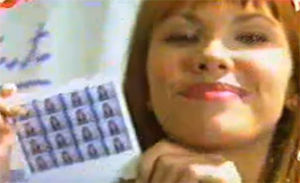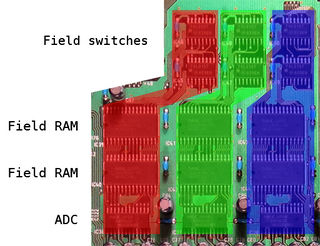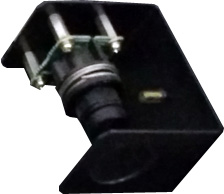Neo Print
The Neo Print was one of SNK's attempts to pull the last dollars from the NeoGeo brand. It was a small purikura (photo booth) from 1996 which ran on a MVS-inspired board, with a camera and printer interface. Players users could add various frames to their picture with more-or-less common themes, SNK characters, before printing them to sticky photo paper.
PCB picture: http://mvs.gotwalls.com/images/e/e1/Pstm-p1_set1_top_nocover.jpg

It was apparently exported to the US for some time ([video ad on Youtube]).
A variety of cartridges were produced with different themes and for US/JP localization.
!!! Preliminary info !!!
Note: Maybe keep all infos regarding the Neo Print in this page ? As it doesn't have that much to do with real NeoGeo systems.
Wiring
From left to right, cartridge label towards you.
- VCN1: GND, GND, +5V, +5V. Draws around 2A with one cart but nothing connected. Expect 2.5A max ?
- RGB OUT: For monitor (pinout ?)
- S-VOUT: For monitor and capture ?
- CCD S-VIN: Camera input, expects NTSC. Luma only can work for testing.
- EX-SVIN: ?
- PRT-SVIN: Printer input (why ?)
- FL: Flash trigger (pinout ?)
- COIN: 3rd pin is the coin switch, active low. Causes an error before attract mode if left floating.
- COUNT: 7th pin triggers test mode, active low.
- CTRL: From the 6th pin: LEFT, RIGHT, OK, CANCEL, GND. Active low.
- VCN2: 9~12V for audio amp and bulbs.
- PRT2: Printer remote. See printer's doc (todo). Both busy lines can be tied together.
- PRT1: Printer remote also (needed or just for backup ?). Busy line can be tied with the 2 other ones.
To satisfy the printer check before attract mode, put the busy lines low for approx. 20ms after the end of each transmission on REMOTE pin (6).
Details
Cartridges
- The cartridges have the exact same mechanical format as MVS cartridges.
- The PROG boards have an identical pinout, some in fact are simple MVS PROGBK1 boards.
- The CHA boards are custom made for the Neo Print and have a different pinout, they have no fix and special graphics ROMs.
- Electrical safety compatibility with MVS carts ? Apparently they just freeze on a black screen without damage.
Blue-labelled cartridges can run alone.
Pink-labelled cartridges are extensions that can only run with a blue one on 2-slots Neo Print boards (they do exist !). Those cartridges only contain graphics ROMs.
Board
Called PSTM-P1. Not JAMMA compatible.
- Backup RAM and RTC.
- Z80 has its own 8MHz oscillator ?
- 68K runs at 12MHz.
- Five 16V8 PALs for glue logic.
- NEO-SDR-T chip for I/O latching and dipswitches.
- The board doesn't have an embedded system ROM, the cartridge's program does everything.
It appears that there is only one type of motherboard, only the vertical daughter board with the cartridge slots changes between 1-slot and 2-slots Neo Print systems.
Video

- The video rendering logic is very different from the regular NeoGeo systems.
- Graphics are loaded from a 16-bit bus.
- No shrinking ? Maybe no sprites at all ?
- The video outputs are "genlocked" to the camera's video signal, no camera means no output.
- PSTG-SNK is used as the only custom graphics chip.
- The camera's video is not simply overlaid with generated graphics but converted digitally and processed as tiles.
- All video I/O is done in S-video (chroma/luma).
- VRAM is made of 4*128kB 8-bit SRAM, probably as 2*256k words.
- A NEC µPC662 triple 8(?) bit video DAC feeds a common Fujitsu MB3516 RGB encoder chip for output.
- 6x NEC µPD42280 dual-port video RAMs (2 fields for each color component) filled by 3 NEC µPC659 video DACs.
- NEC µPC1862 video sync maestro (NTSC).
- 2 Sony CXA1585 chips for s-video to RGB conversion.
- 2 Mitsubishi M52065 triple 2-to-1 high speed analog switches.
To do: Video path diagram.
Dipswitches
To do.
Audio
Sound comes from the same YM2610-YM3016 pair as on the NeoGeo. They're driven by a Z80 and fed by regular V ROMs (ADPCM-B is not used, as in CD systems).
Printer
The stock printer in the Neo Print cab was a Mitsubishi CP-710E "analog video sublimation printer". The Neo Print board "emulates" the printer's remote control via the PRT1 and PRT2 ports (mini DIN 8 and stereo jack).
The printer actually does a "screengrab" from the S-video signal in its internal memory before printing. Apparently, the printer itself does the picture arrangement (1x2, 2x2, or 4x4) and rotation processing to fit on paper, not the Neo Print board itself.
As the photo paper was pre-cut, the Neo Print could only make 4x4 sheets. Software modification should be easy to print a full-frame picture.
Camera
Looks like a standard color NTSC CCTV module with C-mount lens.
 (From a picture by Psykick from Neo-arcadia.com)
(From a picture by Psykick from Neo-arcadia.com)
Probably any S-video capable NTSC camera works.
Why it sucked
- SNK obviously tried to hop on the 90's sticker craze, but as in the usual SNK tradition, it was too late.
- The frames were pretty bland, and the characters weren't that popular (Sega had a similar purikura with a Pokemon license.)
- It hasn't much to do with the NeoGeo, in the end. Proof: it's for girls.
- As any photo booth, it has to be reloaded with paper and ink rolls. Cab operators want money and no servicing. Refilling it every 200 vends had to be annoying.